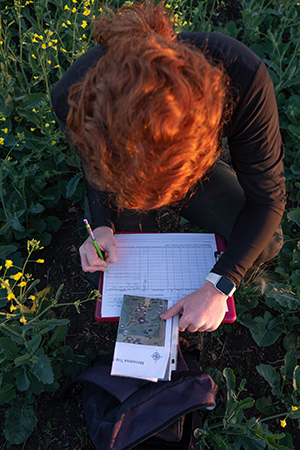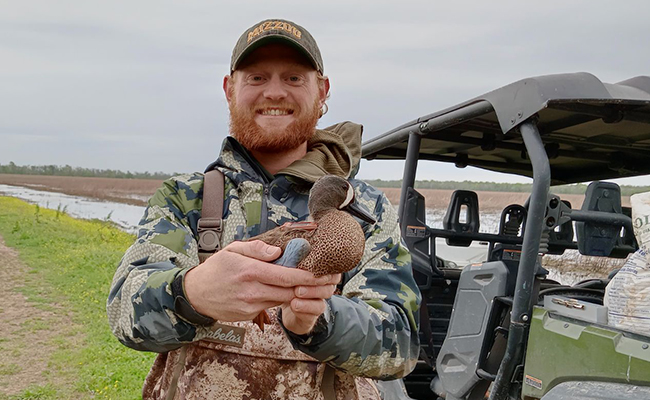Data-Driven Duck Production
Delta Waterfowl’s current research projects aim to put more ducks in the flight and create new opportunities for hunters
Since 1938, when Dr. Albert Hochbaum began his pioneering work as Delta Waterfowl’s first science director at the Delta Marsh, Delta has remained steadfast in its belief that waterfowl management decisions must be rooted in the soundest possible science. This guiding philosophy has shaped the organization’s work for generations.
 Delta continues to lead the way in research focused on ducks and duck hunting issues across North America. This strategic emphasis enables The Duck Hunters Organization to investigate both long-term challenges and emerging concerns that affect waterfowl populations and hunters alike.
Delta continues to lead the way in research focused on ducks and duck hunting issues across North America. This strategic emphasis enables The Duck Hunters Organization to investigate both long-term challenges and emerging concerns that affect waterfowl populations and hunters alike.
The insights gained from Delta’s research are integral to our Duck Production efforts, Habitat Conservation initiatives, and HunteR3 programs. Moreover, our work informs waterfowl management decisions continent-wide—all in support of our mission to produce ducks and secure the future of duck hunting.
This special report offers a snapshot of Delta’s 2025 research projects.
Strategic Placement of Hen Houses
Delta Waterfowl has spent multiple decades gathering a trove of data from many thousands of Hen Houses—work that has positioned the nesting structures as the most effective and cost-effective tools ever devised to put more mallards into every fall f light. Now, graduate student Evan Yunker and Dr. Bruce Dugger of Oregon State University are working with Delta’s Matt Chouinard, Mike Buxton, Dr. Chris Nicolai, and Jacob Bushaw to further fine-tune new Hen House installations. They’re using past data—including variables such as the Hen House installation’s age, proximity to additional nesting structures, distance from the nearest road, and wetland size—to help future Hen Houses to make even more ducks.
California Hen Houses
Delta’s Hen Houses work exceedingly well in the prairie pothole region and other parts of North America, but what about the Intermountain West? In 2023, Oregon State’s Evan Yunker and Dr. Bruce Dugger partnered with Delta’s Dr. Chris Nicolai, Matt Chouinard, and Mike Buxton to set up and monitor 200 Hen Houses across California on federal, state, and private wetlands. The Hen Houses were monitored through 2024 to gauge their use by the Golden State’s breeding mallards and why success might look different than in other regions.
Duck Harvest, Survival, and Sex Ratios
Nearly 100 years ago, research by Aldo Leopold noted that duck populations tend to have a sex ratio of more males than females. This has not changed. In fact, recent studies have indicated that the disparity has increased—likely because nesting hens face risks on the breeding grounds that far outweigh the impact of hunters targeting drakes, and likely to the detriment of duck populations. So, Delta is partnering on research by master’s student Liv Lundin and Dr. Thomas Riecke of the University of Montana to better understand the widening gap. Their findings will help reveal the broader implications of skewed sex ratios in ducks while also aiding in the monitoring and management of the PPR’s breeding ducks.
Waterfowl Graduate Student Retention Survey
Delta and our partners on the North American Waterfowl Management Plan Committee designed a series of surveys to explore why many graduate students study ducks but don’t pursue waterfowl-related career paths. Delta’s Dr. Chris Nicolai and Joel Brice teamed up with Dr. Mike Brasher and Diane Eggeman of Ducks Unlimited and Shaun Oldenburger of Texas Parks and Wildlife to survey 881 former students. The data being analyzed promises to reveal what keeps people in—or pushes them out of—the waterfowl management profession. Early results show that strong professional relationships and a sense of performing valuable work are key to students staying in wildlife careers.
Evaluating Styles of Radio Attachments
For decades, scientists have used small radios to track duck behavior, hunter harvest rates, and survival. But what’s the best way to attach those radios to ensure that the ducks and data aren’t affected? Researchers intent on finding out include graduate student Kelsey Huss, Dr. Karen Machin, and Dr. Mitch Weegman of the University of Saskatchewan, along with Blake Bartzen of the Canadian Wildlife Service, Paul Link from the Louisiana Department of Wildlife and Fisheries, Dr. Matt Dyson from Ducks Unlimited- Canada, and Delta’s Dr. Chris Nicolai. Launched in 2022, the project is testing multiple styles of attachment—two- and one-strap backpacks, implants, and subdermal radios—distributed evenly across about 120 female mallards each year in the eastern prairie pothole region. Finally, data collected from the study’s leg-mounted geolocators will be compared to ducks wearing standard leg bands for a comprehensive assessment of contemporary attachment styles.
Prairie Canada Nest and Brood Success
Delta has expanded Predator Management research into all of prairie Canada, and we are now measuring its effectiveness using some new, cutting-edge tools. In addition to documenting nest success, the study will monitor some traditionally difficult rates to measure—including brood survival and the total number of ducklings produced—across multiple trapped and non-trapped study blocks. Ph.D. student Grant Rhodes and Dr. Kevin Ringelman of University of California-Davis, and Delta’s Dr. Chris Nicolai will explore the use of high-tech tools, including drones, VHF radios, and nasal saddles attached to incubating hens. Ultimately, they hope to provide future waterfowl managers with a more efficient and accurate means of measuring brood production rates in the wake of management actions.
Using Drones to Monitor Canvasback Broods, Predator Management
Canvasback populations are being limited by lagging production. Therefore, improving nest success and brood survival is of paramount importance to waterfowl managers and duck hunters. Unfortunately, multiple years of Predator Management research in the Minnedosa, Manitoba, region—a prime location for breeding canvasbacks— have netted mixed results for canvasback nest success. However, the number of canvasback broods has proven consistently higher in areas where Predator Management techniques are applied, suggesting a promising effect not captured by traditional nest monitoring. To further explore this potential breakthrough, drones equipped with multi-spectral cameras will be used to study canvasback brood abundance and movements when Predator Management is applied on active and control sites. Delta staff and master’s student Rich Cain and Dr. Kevin Ringelman of University of California-Davis will mark individual, brood-attending hens with “nasal saddles,” which will allow broods to be tracked and identified, while also enhancing our understanding of variable detection rates throughout the breeding season.
Hot Spot Trapping to Boost Production in Various Habitats
Some regions of the PPR with strong densities of breeding ducks and relatively abundant grassy areas—typically a good combination—are still having poor, below-break-even nest success rates. So, graduate student Jack Johnson and Dr. Ben Sedinger of the University of Wisconsin–Stevens Point are working with Delta’s Dr. Chris Nicolai, Dr. Frank Rohwer, Joel Brice, Jacob Bushaw, Mike Buxton, and Matt Chouinard to study how trapping predators performs across areas of South Dakota with varied amounts of grass covers. Additionally, we intend to develop new methods for assessing pair and brood abundance on hot-spot trapped sites, which will help inform future Delta Duck Production decisions. This project began with a pilot year in 2024 and expands to a full-scale project in 2025 and 2026 with an eye toward further identifying the most effective landscapes to apply Delta’s Predator Management.
Enhancing Predator Management in Alberta
Southern Alberta has always been a critical region for breeding ducks. However, while its mix of prairie and parkland habitat was once composed of high wetland densities and large expanses of nesting cover, the modern landscape has a heavy agricultural presence. This is among the reasons why populations of meso-predators, such as striped skunks, raccoons, and ravens, have grown and even expanded their ranges into areas where they didn’t formerly exist.
This research project seeks to provide a contemporary assessment of the impacts of meso-predators on duck nest success in all-important Alberta. We will accomplish this by determining nest success across three 25-square-mile sites where Predator Management trapping is applied and comparing these results to three 25-square-mile control sites.
A pilot study begun by Delta staff during the 2024 nesting season will be monitored by technicians in 2025.
Decoding Dynamics of Ducks at a Continental Scale
Last winter, Delta began a pilot study to understand “source-sink” population dynamics— that is, how some habitats consistently produce more birds than they lose (sources), while others result in a net loss (sinks)—of canvasbacks across North America. The western portion of the project began with geolocator tagging of female canvasbacks wintering near California’s San Francisco Bay; in the East, canvasbacks were tagged in the Chesapeake Bay region; and in the mid-continent, we tagged canvasbacks in the Mississippi Flyway on Pool 19 of the Mississippi River. The tiny geolocators will help identify spring and fall migration patterns, nest locations, and survival. Researchers will also gather feathers for isotopic analysis to determine where juvenile canvasbacks are being produced and where adult females molt. The long-term goal of the project’s collaborators—Delta’s Dr. Chris Nicolai, Dr. Ben Sedinger of the University of Wisconsin–Stevens Point, and a graduate student—is to identify canvasbacks’ key breeding and staging areas, improve understanding of population variation across regions, and assess factors affecting production. (Delta Waterfowl extends special thanks to UW–Stevens Point graduate student Hannah Sabatier for helping launch this important study.)
Determining Sources of Atlantic Flyway Dabblers
The Atlantic Flyway’s green-winged teal, gadwall, and wigeon are among the most important species to hunters in southern states and, even farther north, they especially contribute to hunter satisfaction prior to the arrival of mallards and black ducks. However, traditional surveys and banding offer limited insights into the origins of these species—which account for nearly 20% of the Atlantic’s overall harvest—particularly for under-sampled regions like northern Quebec. Therefore, Delta Waterfowl is partnering with Dr. Michael Schummer and graduate student Izzy Eagen at the State University of New York’s College of Environmental Science and Forestry to map likely breeding areas through combining stable isotope analysis of hunter-harvested feathers with band recovery vectors. In doing so, we hope to identify the quantity of ducks produced in the PPR versus eastern North America in the Atlantic’s hunter harvest, which will help inform the Atlantic Flyway’s multistock adaptive harvest regulations model and other future management decisions.
Evaluating New Methods to Mark Nests
Delta’s Jake Bushaw and Dr. Chris Nicolai are evaluating whether common methods used by scientists to mark the locations of duck nests may be unintentionally attracting predators. In particular, we want to know whether savvy ravens, which have increased in number across the PPR, are keying on the nest markers to find easy meals. Traditionally, a painted wooden stake is placed 10 meters north of a nest, along with a 1/8-inch welding rod placed beside the nest bowl. This study will explore whether new, possibly less conspicuous marking techniques—such as using more natural-looking markers, removing the stake entirely, or not walking directly to the nest at discovery—result in fewer nests being depredated. Results from this work could shape future best practices for upland nest monitoring.
Increasing Hen House Occupancy
Delta is exploring whether a single Hen House can successfully support two hen mallard nests. In February 2025, Delta’s Jake Bushaw installed center dividers into 40 Hen Houses—effectively creating two compartments per nesting structure—near Delta’s Field Research Station, southeast of Minnedosa, Manitoba. Bushaw then identified an additional 40 Hen Houses nearby, which were left unchanged to serve as the study’s controls. Undergraduate research student Sam Flanjak of the University of Lethbridge, along with Delta’s Matt Chouinard, Dr. Chris Nicolai, and Bushaw, will monitor all structures throughout nesting seasons to see whether dividers influence the use of Hen Houses. The findings could offer a simple, efficient means of doubling occupancy across Delta’s fleet of Hen Houses without expanding the program’s footprint.
Dr. Chris Nicolai is a waterfowl scientist for Delta Waterfowl.
The post Data-Driven Duck Production appeared first on Delta Waterfowl.
This article originally appeared on this site.



Leave a Reply